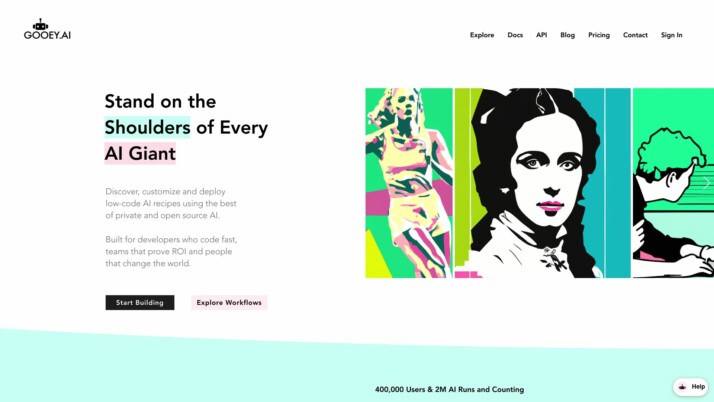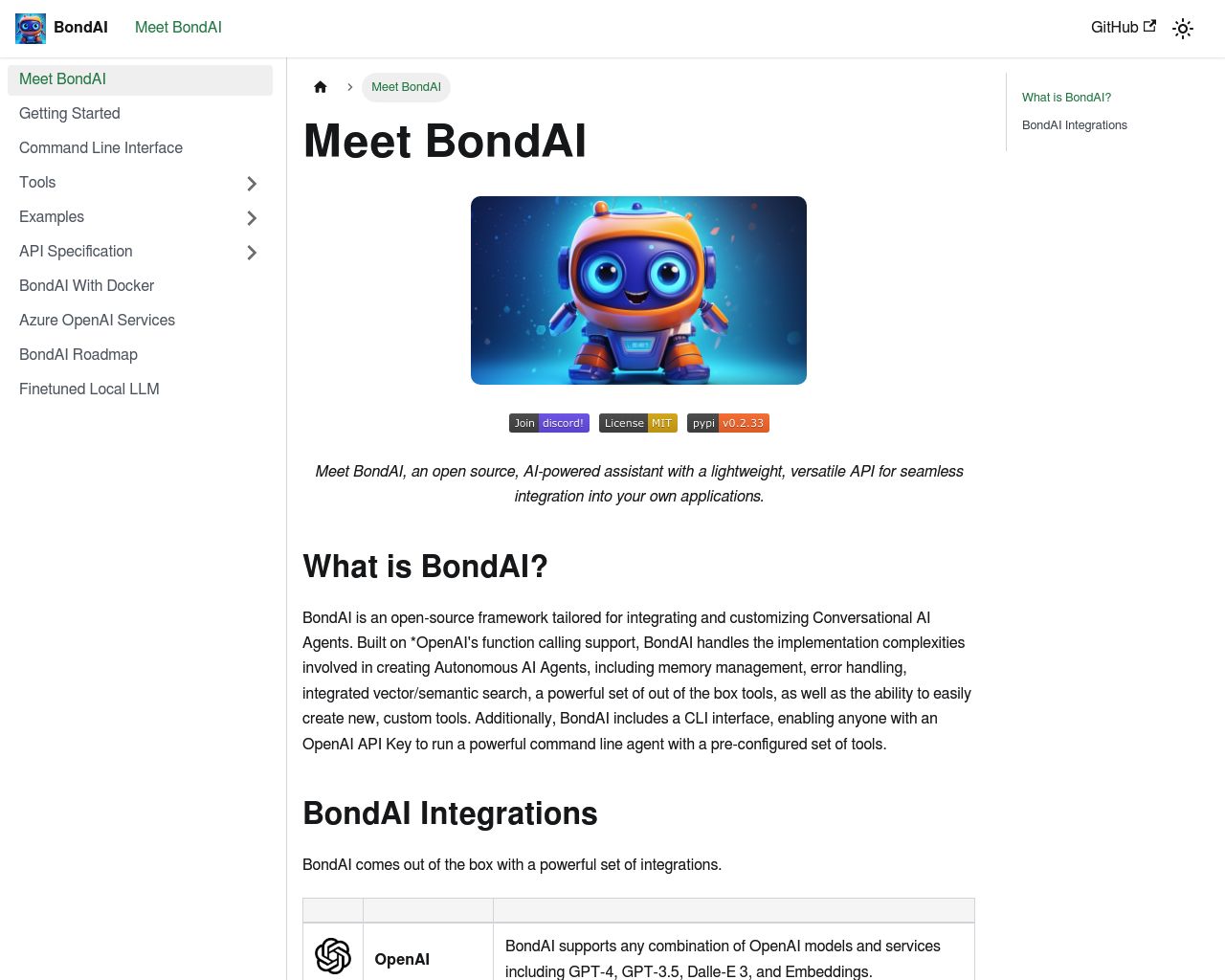Gooey AI vs. BondAI: Comparing AI Development Platforms
AI agent development platforms empower businesses to harness cutting-edge technology for improved efficiency and customer engagement. This comparison examines Gooey AI’s user-friendly approach to building conversational AI agents and BondAI’s flexible open-source framework for developers. We’ll explore how these platforms stack up against SmythOS, our comprehensive solution that combines ease of use with powerful customization.
By analyzing key features, integration capabilities, and deployment options, we aim to help you choose the ideal AI development tool for your specific needs. Whether you’re a developer seeking advanced customization or a business leader looking for scalable AI solutions, this review provides valuable insights to guide your decision-making process.
Gooey AI Overview
Gooey AI empowers users to create sophisticated AI solutions without extensive coding knowledge. The platform specializes in building advanced chatbots, known as AI Copilots, leveraging multiple large language models including OpenAI’s GPT-3.5 and GPT-4, and Google’s PaLM2.
Gooey AI’s no-code interface simplifies the development of AI-powered conversational agents, making it accessible to both technical and non-technical users. The platform’s strengths lie in its integration capabilities, supporting connections with popular communication platforms like Facebook, Slack, WhatsApp, and Instagram. This versatility allows businesses to deploy AI solutions across various customer touchpoints effectively.


Screenshot of Gooey AI Website
Gooey AI’s no-code interface simplifies the development of AI-powered conversational agents, making it accessible to both technical and non-technical users.
The platform excels in data processing and information retrieval. Its Retrieval Augmented Generation (RAG) feature enhances the accuracy and relevance of AI responses by searching through indexed domain-specific documents. Gooey AI also offers synthetic data extraction, transforming videos and PDFs into editable formats, creating FAQs, and enhancing data with citations. These features significantly improve search results and information accessibility.
Gooey AI’s multimodal capabilities set it apart, supporting text, audio, and video inputs and outputs. The platform includes advanced speech recognition and translation features, powered by models from Azure, Google, Meta, and OpenAI. This multilingual support expands the potential applications of AI agents across diverse industries and use cases.
While Gooey AI offers robust features for building and deploying AI solutions, it may have limitations in certain areas. The platform doesn’t explicitly mention a visual workflow builder or a dedicated debug mode, which could impact the ease of creating complex AI workflows and troubleshooting issues. Additionally, the absence of a sitemap crawler or URL crawler might limit automated data collection capabilities for some users.
BondAI Overview
BondAI empowers developers to craft sophisticated AI Agent Systems through an open-source framework. This platform simplifies complex aspects of autonomous AI agent creation, including memory management, error handling, and semantic search capabilities.


BondAI’s architecture supports advanced AI models like ReAct Agents and ConversationalAgents, enabling both individual interactions and multi-agent systems. This versatility allows for tackling complex tasks that surpass single-agent model capabilities. The framework seamlessly integrates with popular services such as OpenAI’s GPT models, Microsoft Azure, and Google Search, expanding its utility across various applications from research to customer support.
BondAI’s architecture supports advanced AI models… enabling both individual interactions and multi-agent systems. This versatility allows for tackling complex tasks that surpass single-agent model capabilities.
A standout feature of BondAI is its robust memory management system, inspired by the MemGPT paper. This tiered approach efficiently handles extensive contexts and complex conversations, utilizing core memory for immediate tasks, conversation memory for dialogue history, and archival memory for long-term data storage. This structure enhances the problem-solving capabilities of BondAI agents, allowing for more nuanced and context-aware interactions.
A standout feature of BondAI is its robust memory management system… This structure enhances the problem-solving capabilities of BondAI agents, allowing for more nuanced and context-aware interactions.
BondAI offers flexible deployment options, including a Command Line Interface (CLI), Docker containers, and direct codebase integration. This adaptability allows users to quickly start with pre-configured tools or build custom agents tailored to specific needs. However, BondAI may present a steeper learning curve for non-technical users compared to some visual builder platforms, potentially limiting its accessibility for those without programming experience.
While BondAI excels in providing a comprehensive toolkit for AI agent development, it may require more setup and configuration compared to fully hosted solutions. This trade-off offers greater control and customization at the cost of immediate out-of-the-box functionality. For developers and organizations seeking to push the boundaries of AI agent capabilities, BondAI presents a powerful and flexible option in the evolving landscape of AI development tools.
Feature Comparison
Gooey AI and BondAI offer distinct approaches to AI agent development, each with its own strengths and limitations. Gooey AI provides a user-friendly platform for building conversational AI agents, while BondAI offers a more flexible open-source framework for developers.
Gooey AI excels in its no-code interface and integration capabilities with popular communication platforms. It supports multimodal inputs and outputs, including text, audio, and video. However, Gooey AI lacks a visual workflow builder and debug mode, which could hinder complex AI workflow creation and troubleshooting.
BondAI, on the other hand, provides a robust memory management system and supports advanced AI architectures like ReAct Agents and ConversationalAgents. It offers greater customization options and flexibility for developers but may present a steeper learning curve for non-technical users. BondAI’s open-source nature allows for deep customization but requires more setup and configuration compared to hosted solutions like Gooey AI.
In contrast, SmythOS offers a comprehensive suite of features that addresses the limitations of both Gooey AI and BondAI. Our platform combines the ease of use of a visual builder with the flexibility of advanced customization options. We provide a debug mode for efficient troubleshooting and a sitemap crawler for automated data collection, features missing in both Gooey AI and BondAI. SmythOS also offers superior scalability and deployment options, making it a more versatile choice for businesses of all sizes.
Feature Comparison Table
| Gooey AI | BondAI | SmythOS | |
|---|---|---|---|
| CORE FEATURES | |||
| Visual Builder | ✅ | ❌ | ✅ |
| No-Code Options | ✅ | ❌ | ✅ |
| Audit Logs for Analytics | ✅ | ❌ | ✅ |
| SECURITY | |||
| Constrained Alignment | ✅ | ❌ | ✅ |
| IP Control | ❌ | ❌ | ✅ |
| COMPONENTS | |||
| Zapier APIs | ❌ | ✅ | ✅ |
| Data Lakes | ❌ | ❌ | ✅ |
| DEPLOYMENT OPTIONS (EMBODIMENTS) | |||
| Staging Domains | ❌ | ❌ | ✅ |
| Production Domains | ❌ | ✅ | ✅ |
| Deploy as Scheduled Agent | ✅ | ❌ | ✅ |
| DATA LAKE SUPPORT | |||
| Hosted Vector Database | ✅ | ❌ | ✅ |
| Sitemap Crawler | ❌ | ❌ | ✅ |
| YouTube Transcript Crawler | ✅ | ❌ | ✅ |
Best Alternative to Gooey AI and BondAI
SmythOS stands out as the superior alternative to Gooey AI and BondAI, offering a comprehensive and user-friendly platform for AI agent development. We combine the best features of both competitors while addressing their limitations, providing a powerful solution for businesses and developers alike.
Our visual builder simplifies the creation of complex AI workflows, allowing users to design sophisticated agents without extensive coding knowledge. This feature surpasses Gooey AI’s no-code interface and BondAI’s developer-focused approach, making AI development accessible to a broader audience while maintaining advanced capabilities for experienced users.
SmythOS offers unparalleled flexibility in deployment options… providing seamless integration with various platforms, including Google Vertex, Microsoft Copilot, and Amazon Web Services Bedrock.
Unlike Gooey AI and BondAI, SmythOS offers unparalleled flexibility in deployment options. We provide seamless integration with various platforms, including Google Vertex, Microsoft Copilot, and Amazon Web Services Bedrock. This versatility ensures that AI solutions can be easily incorporated into existing systems, addressing a key limitation of our competitors.
SmythOS excels in scalability and performance, critical factors often overlooked by other platforms. Our hosted agents for development and production environments, coupled with robust staging and production domains, enable smooth transitions from testing to full-scale deployment. This scalability is particularly valuable for growing businesses and enterprise-level applications, setting us apart from both Gooey AI and BondAI.
We take pride in our comprehensive feature set, which includes capabilities absent in both Gooey AI and BondAI. Our platform offers a debug mode for efficient troubleshooting, a sitemap crawler for automated data collection, and advanced security features like IP control. These additions, combined with our intuitive interface and extensive integration options, make SmythOS the ideal choice for organizations seeking a powerful, versatile, and user-friendly AI agent development platform.
Conclusion
Gooey AI and BondAI offer distinct approaches to AI agent development, each with unique strengths. Gooey AI provides a user-friendly platform for building conversational AI agents with multimodal capabilities and integration options. BondAI, as an open-source framework, offers developers flexibility and advanced memory management features.
However, SmythOS emerges as the superior choice, addressing limitations of both platforms while offering unparalleled versatility. Our drag-and-drop interface combines ease of use with powerful customization options, making AI development accessible to both technical and non-technical users. We provide robust debugging tools, automated data collection features, and superior scalability options missing in both Gooey AI and BondAI.
SmythOS’s extensive integration ecosystem, supporting over 300,000 connections, empowers users to create sophisticated AI workflows effortlessly. Our “Create Once, Deploy Anywhere” approach allows seamless deployment across various platforms, from APIs to chatbots and scheduled agents. This flexibility, combined with our comprehensive feature set, positions SmythOS as the ideal solution for businesses seeking to harness AI’s full potential.
To experience the power of SmythOS firsthand, create a free account today. Explore our diverse range of AI-powered agent templates to jumpstart your projects, or dive into our comprehensive documentation to unlock the full capabilities of our platform. Join us in revolutionizing AI development and deployment – your journey towards effortless AI innovation starts here.
Last updated:
Disclaimer: The information presented in this article is for general informational purposes only and is provided as is. While we strive to keep the content up-to-date and accurate, we make no representations or warranties of any kind, express or implied, about the completeness, accuracy, reliability, suitability, or availability of the information contained in this article.
Any reliance you place on such information is strictly at your own risk. We reserve the right to make additions, deletions, or modifications to the contents of this article at any time without prior notice.
In no event will we be liable for any loss or damage including without limitation, indirect or consequential loss or damage, or any loss or damage whatsoever arising from loss of data, profits, or any other loss not specified herein arising out of, or in connection with, the use of this article.
Despite our best efforts, this article may contain oversights, errors, or omissions. If you notice any inaccuracies or have concerns about the content, please report them through our content feedback form. Your input helps us maintain the quality and reliability of our information.
